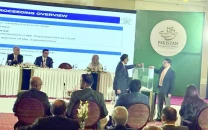Opp needs 10 more votes for simple majority: Abbasi
Former premier says no-confidence motion can succeed if the ‘state’ remains neutral

As political temperature rises with the possibility of a move of no-confidence motion next month, Pakistan Muslim League-Nawaz (PML-N) senior leader Shahid Khaqan Abbasi has said that the opposition merely needs 10 additional votes to gain a simple majority in the National Assembly (NA).
The former prime minister said that these extra votes can come from the lawmakers of the ruling Pakistan Tehreek-e-Insaf (PTI). He said that the opposition parties have 162 lawmakers against the government’s 180.
“Opposition needs only 10 additional votes. They can come from PTI MNAs,” the ex-premier said days after he claimed that 22 MNAs of the ruling party were ready to jump ship but would stay with the government as long as the ‘state’ – a tacit reference to establishment – was with the incumbent government.
On the role of the ‘state’ during no-confidence motion, the PML-N leader said that the “neutrality or not of the state will become visible over the next few days”. When asked how the neutrality of the powers that be can be determined, Abbasi simply said: “If no phone calls come.”
Numbers game:
Excluding Jamat-e-Islami’s one vote, the former premier said that the government has total 179 members, including PTI’s 156 members; Muttahida Qaumi Movement-Pakistan’s (MQM-P) 7; Pakistan Muslim League-Quaid’s (PML-Q) 5; Balochistan Awami Party’s (BAP) 5; Grand Democratic Alliance’s (GDA) 3; and one each from Awami Muslim League Pakistan (AMLP), Jamhoori Watan Party (JWP) and an independent member. With the demise of one PTI lawmaker, he said, the treasury benches’ total number stands at 178.
READ Opposition’s no-trust plan 'gaining steam'
While commenting on the opposition numbers in the lower house, he maintained that the opposition has a total of 162 votes, including 84 of PML-N; 56 of Pakistan People’s Party Parliamentarians (PPPP); 14 of Muttahida Majlis–e–Amal (MMAP); 4 of Balochistan National Party (BNP); three independent candidates and one from Awami National Party (ANP).
Since JI’s one vote can go either way, therefore, the government’s number can either reach 179 or the opposition’s strength can touch 163 members. With the demise of one MNA, the house’s current strength stands at 341 and if JI abstains from voting then the total votes would be 340 out of the total 342 lawmakers.
“You can also safely delete Noor Alam Khan from government’s side,” Abbasi quipped. Noor has been vocal against the government policies and recently demanded that the name of the lawmakers sitting in the first three rows of the treasury benches should be put on Exit Control List (ECL) – a demand which led to his removal from the Public Accounts Committee (PAC) and serving of a notice from PTI.
Abbasi has been constantly saying that the opposition parties can pull off the no-confidence motion provided that the ‘state’ remains neutral. While relying on PTI MNAs, he even went on to say that the opposition can go ahead with no-confidence move even without PML-Q – PTI’s only ally in the Centre and Punjab, saying PML-Q’s policy was dictated by its alignment with the ‘state’.
Federal Minister for Information and Broadcasting Chaudhry Fawad Hussain was asked to comment on the opposition’s fresh claim that it only needed 10 more votes to show simple majority and that can come from PTI, but his reply did not come till the filing of the story.
He was also asked to comment on the chances of PTI MNAs jumping the ship or allies leaving PTI alone but to no avail. Earlier, he had, however, denied the possibility of defection and claimed that hardly a single person would leave the party.
Simple majority refers to the highest number of votes cast for any one candidate, issue, or item or the majority of more than 50 percent of the house’s total membership. In order to make no-confidence motion successful, opposition has not only shown unity in the recent past but is already engaged in meetings with government’s allies in efforts to buttress its force against the government.



















COMMENTS
Comments are moderated and generally will be posted if they are on-topic and not abusive.
For more information, please see our Comments FAQ